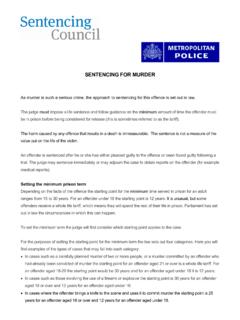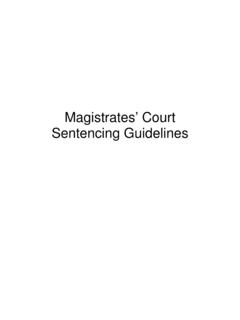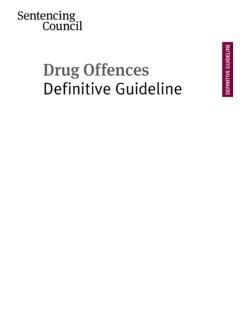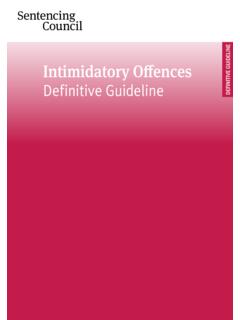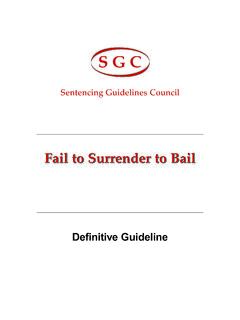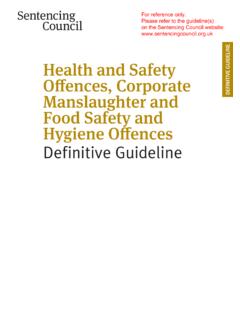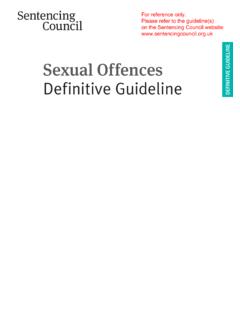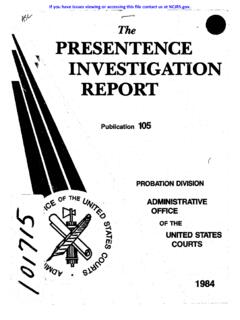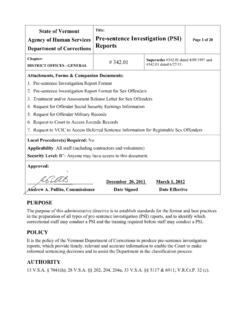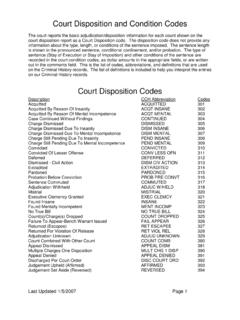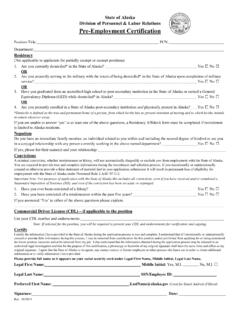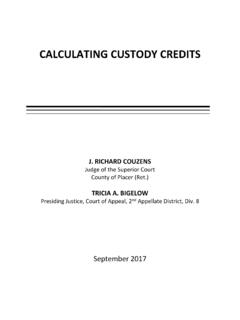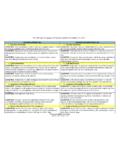Transcription of Reduction in Sentence DEFINITIVE GUIDELINE
1 DEFINITIVE GUIDELINER eduction in Sentence for a Guilty pleaDefinitive GuidelineFor reference only. Please refer to the GUIDELINE (s) on the Sentencing Council website: For reference only. Please refer to the GUIDELINE (s) on the Sentencing Council website: Reduction in Sentence for a Guilty Plea DEFINITIVE GUIDELINE 3 Effective from 1 June 2017 Reduction IN Sentence FOR A GUILTY PLEAN othing in this GUIDELINE affects the duty of the parties to progress cases (including the service of material) and identify any issues in dispute in compliance with the Criminal Procedure Rules and Criminal Practice in Sentence for a Guilty PleaSection 144 of the Criminal Justice Act 2003 provides:(1) In determining what Sentence to pass on an offender who has pleaded guilty to an offence1 in proceedings before that court or another court, a court must take into account.
2 (a) the stage in the proceedings for the offence at which the offender indicated his intention to plead guilty, and (b) the circumstances in which this indication was Offence includes breach of an order where this constitutes a separate criminal offence but not breach of terms of a Sentence or reference only. Please refer to the GUIDELINE (s) on the Sentencing Council website: 4 Reduction in Sentence for a Guilty Plea DEFINITIVE GuidelineEffective from 1 June 2017 Reduction IN Sentence FOR A GUILTY PLEAA. APPLICABILITY OF GUIDELINEThe Sentencing Council issues this DEFINITIVE GUIDELINE in accordance with section 120 of the Coroners and Justice Act 2009. Section 125(1) of the Coroners and Justice Act 2009 provides that when sentencing offences committed after 6 April 2010: Every court -(a) must, in sentencing an offender, follow any sentencing guidelines which are relevant to the offender s case, and(b) must, in exercising any other function relating to the sentencing of offenders, follow any sentencing guidelines which are relevant to the exercise of the function, unless the court is satisfied that it would be contrary to the interests of justice to do so.
3 This GUIDELINE applies regardless of the date of the offence to all individual offenders aged 18 and older and to organisations in cases where the first hearing is on or after 1 June 2017. The GUIDELINE applies equally in magistrates courts and the Crown Court. Guidance on reductions in Sentence for a guilty plea for under 18s is contained in the Sentencing Council Overarching Principles - Sentencing Children and Young People GUIDELINE to which sentencers should KEY PRINCIPLES The purpose of this GUIDELINE is to encourage those who are going to plead guilty to do so as early in the court process as possible. Nothing in the GUIDELINE should be used to put pressure on a defendant to plead a guilty person is entitled not to admit the offence and to put the prosecution to proof of its case, an acceptance of guilt: a) normally reduces the impact of the crime upon victims; b) saves victims and witnesses from having to testify; and c) is in the public interest in that it saves public time and money on investigations and trials.
4 A guilty plea produces greater benefits the earlier the plea is indicated. In order to maximise the above benefits and to provide an incentive to those who are guilty to indicate a guilty plea as early as possible, this GUIDELINE makes a clear distinction between a Reduction in the Sentence available at the first stage of the proceedings and a Reduction in the Sentence available at a later stage of the purpose of reducing the Sentence for a guilty plea is to yield the benefits described above. The guilty plea should be considered by the court to be independent of the offender s personal mitigation. Factors such as admissions at interview, co-operation with the investigation and demonstrations of remorse should not be taken into account in determining the level of Reduction .
5 Rather, they should be considered separately and prior to any guilty plea Reduction , as potential mitigating factors. The benefits apply regardless of the strength of the evidence against an offender. The strength of the evidence should not be taken into account when determining the level of Reduction . The GUIDELINE applies only to the punitive elements of the Sentence and has no impact on ancillary orders including orders of disqualification from driving. For reference only. Please refer to the GUIDELINE (s) on the Sentencing Council website: Reduction in Sentence for a Guilty Plea DEFINITIVE GUIDELINE 5 Effective from 1 June 2017 Reduction IN Sentence FOR A GUILTY PLEAC. THE APPROACHS tage 1: D etermine the appropriate Sentence for the offence(s) in accordance with any offence specific sentencing 2: Determine the level of Reduction for a guilty plea in accordance with this GUIDELINE .
6 Stage 3: State the amount of that 4: Apply the Reduction to the appropriate 5: Follow any further steps in the offence specific GUIDELINE to determine the final DETERMINING THE LEVEL OF REDUCTIONThe maximum level of Reduction in Sentence for a guilty plea is one-thirdD1. Plea indicated at the first stage of the proceedings Where a guilty plea is indicated at the first stage of proceedings a Reduction of one-third should be made (subject to the exceptions in section F). The first stage will normally be the first hearing at which a plea or indication of plea is sought and recorded by the Plea indicated after the first stage of proceedings maximum one quarter sliding scale of Reduction thereafterAfter the first stage of the proceedings the maximum level of Reduction is one-quarter (subject to the exceptions in section F).
7 The Reduction should be decreased from one-quarter to a maximum of one-tenth on the first day of trial having regard to the time when the guilty plea is first indicated to the court relative to the progress of the case and the trial date (subject to the exceptions in section F). The Reduction should normally be decreased further, even to zero, if the guilty plea is entered during the course of the the purposes of this GUIDELINE a trial will be deemed to have started when pre-recorded cross-examination has In cases where (in accordance with the Criminal Procedure Rules) a defendant is given the opportunity to enter a guilty plea without attending a court hearing, doing so within the required time limits will constitute a plea at the first stage of reference only.
8 Please refer to the GUIDELINE (s) on the Sentencing Council website: 6 Reduction in Sentence for a Guilty Plea DEFINITIVE GuidelineEffective from 1 June 2017 Reduction IN Sentence FOR A GUILTY PLEAE. APPLYING THE Reduction E1. Imposing one type of Sentence rather than anotherThe Reduction in Sentence for a guilty plea can be taken into account by imposing one type of Sentence rather than another; for example: by reducing a custodial Sentence to a community Sentence , or by reducing a community Sentence to a fine. Where a court has imposed one Sentence rather than another to reflect the guilty plea there should normally be no further Reduction on account of the guilty plea. Where, however, the less severe type of Sentence is justified by other factors, the appropriate Reduction for the plea should be applied in the normal More than one summary offence When dealing with more than one summary offence, the aggregate Sentence is limited to a maximum of six months.
9 Allowing for a Reduction for each guilty plea, consecutive sentences might result in the imposition of the maximum six month Sentence . Where this is the case, the court may make a modest additional Reduction to the overall Sentence to reflect the benefits derived from the guilty Keeping an either way case in the magistrates court to reflect a guilty pleaReducing a custodial Sentence to reflect a guilty plea may enable a magistrates court to retain jurisdiction of an either way offence rather than committing the case for Sentence to the Crown Court. In such cases a magistrates court should apply the appropriate Reduction to the Sentence for the offence(s) arrived at in accordance with any offence specific sentencing GUIDELINE and if the resulting Sentence is then within its jurisdiction it should go on to reference only.
10 Please refer to the GUIDELINE (s) on the Sentencing Council website: Reduction in Sentence for a Guilty Plea DEFINITIVE GUIDELINE 7 Effective from 1 June 2017 Reduction IN Sentence FOR A GUILTY PLEAF. EXCEPTIONS F1. Further information, assistance or advice necessary before indicating pleaWhere the sentencing court is satisfied that there were particular circumstances which significantly reduced the defendant s ability to understand what was alleged or otherwise made it unreasonable to expect the defendant to indicate a guilty plea sooner than was done, a Reduction of one-third should still be considering whether this exception applies, sentencers should distinguish between cases in which it is necessary to receive advice and/or have sight of evidence in order to understand whether the defendant is in fact and law guilty of the offence(s) charged, and cases in which a defendant merely delays guilty plea(s)

